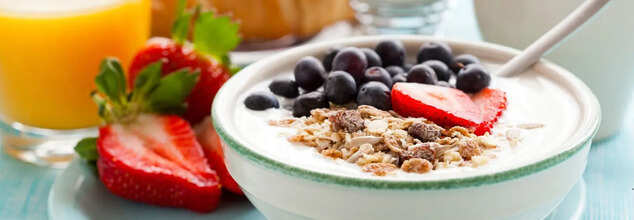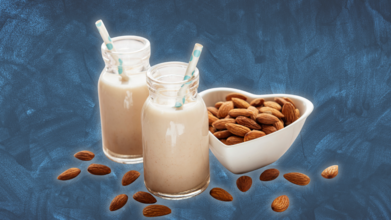- Health Conditions A-Z
- Health & Wellness
- Nutrition
- Fitness
- Health News
- Ayurveda
- Videos
- Medicine A-Z
- Parenting
- Web Stories
Coffee, Eggs And Berries: Healthy Breakfast Ideas That Support Weight Loss

breakfast (credit: canva)
Breakfast holds a significant place in one's diet. Not only does it kickstart your day and boost your metabolism, but a healthy breakfast also aids weight loss. Eating a plate loaded with fibre and protein can keep your appetite in check for the rest of the day. On the flip side, eating sugar could prove detrimental. In this article, we provide you with healthy breakfast ideas that will help you shed those extra pounds.
Healthy Breakfast Ideas
1. Eggs: Packed with protein and essential vitamins like selenium and riboflavin, eggs are a nutritional powerhouse. High protein content in eggs can help reduce appetite, potentially aiding weight loss.2. Wheat Germ: This wheat kernel component is rich in vitamins and fiber, with nearly 4 grams per ounce. Its high fiber content may enhance weight loss by increasing satiety.
3. Bananas: With over 100 calories and 3 grams of fiber per medium fruit, bananas are low-calorie and high in dietary fiber. Resistant starch in unripe bananas may also help reduce food intake and decrease belly fat.
4. Yogurt: Greek yogurt is a protein-rich option that supports weight loss, particularly when paired with exercise and a balanced diet.
5. Smoothies: Customizable to your preferences, smoothies can be packed with veggies and low-calorie fruits to boost fiber intake and fullness. Opt for high-protein ingredients like Greek yogurt or tofu to keep hunger at bay.
6. Berries: Rich in fiber and vital nutrients, berries can help reduce hunger and lower the risk of chronic diseases. Their high fiber content supports weight management.
7. Grapefruits: Low in calories and high in water and fiber, grapefruits may aid weight loss. Citrus polyphenols like naringenin could help protect metabolism, though more research is needed.
8. Coffee: Caffeine in coffee can boost metabolism and fat burning, supporting weight loss. Avoid excess sugar and cream to maximize benefits.
9. Kiwis: High in vitamin C, potassium, and fiber, kiwis can improve fullness, reduce appetite, and aid in digestion.
10. Green Tea: Known for its metabolism-boosting properties, green tea may help reduce belly fat. Enhance your tea with lemon, honey, or fresh herbs for added flavor.
11. Chia Seeds: These seeds expand in the stomach, promoting fullness and reducing hunger. They are also high in fiber and protein, which may help with weight control.
12. Oatmeal: Low in calories and high in beta-glucan fiber, oatmeal can balance blood sugar levels and manage appetite, making it a great choice for weight loss.
13. Flaxseeds: Rich in soluble fiber, flaxseeds slow digestion and help control appetite, supporting weight loss efforts.
14. Nuts: A blend of fiber, protein, and healthy fats, nuts can aid weight loss, though portion control is crucial due to their calorie density.
Artificial Sweeteners Could Accelerate Brain Decline By 1.5 Years, Study Finds

Credits: iStock
Artificial sweeteners have long been marketed as healthier alternatives to sugar. They sit in diet sodas, low-calorie yogurts, protein bars, and “sugar-free” treats, promising sweetness without guilt. But a new large-scale study suggests the tradeoff might be sharper than expected: faster brain aging.
Researchers in Brazil have found that people who consumed the highest levels of artificial sweeteners—roughly the equivalent of one diet soda a day—showed significantly steeper cognitive decline compared to those who consumed little or none. On average, their brains appeared to age about 1.6 years faster.
The findings, published in Neurology, add to mounting concerns about the long-term impact of low- and no-calorie sweeteners on human health, particularly when it comes to the brain.
The study tracked nearly 13,000 Brazilian adults, ages 35 to 75, as part of the Brazilian Longitudinal Study of Adult Health. Participants’ diets were assessed at the beginning of the study, and their memory and thinking skills were tested three times over eight years.
Those who consumed the most artificial sweeteners—an average of 191 milligrams a day, about a teaspoon—experienced a 62% faster global cognitive decline. That translates to about 1.6 years of additional brain aging compared to people consuming the least.
Even moderate consumers, averaging 66 milligrams a day, showed accelerated decline: 35% faster cognitive aging, or about 1.3 years.
“This study does not prove cause and effect, but the association is concerning,” said lead author Dr. Claudia Kimie Suemoto, a geriatrician at the University of São Paulo’s Medical School. “We know these sweeteners are linked to worse cognitive trajectories.”
Why Do Cognitive Functions Get Most Affected By Artificial Sweeteners?
The tests measured verbal fluency, working memory, word recall, and processing speed. Working memory—holding information to solve problems or learn new skills—was particularly impacted. Verbal fluency, or the ability to quickly produce words, also declined more steeply among heavy consumers.
Interestingly, the link between sweetener consumption and faster decline was strongest in adults under 60. Older participants did not show the same pattern, suggesting that younger brains may be more vulnerable to long-term effects.
Which Sweeteners Were Linked to Early Brain Decline?
Researchers examined several widely used sweeteners, including:
- Aspartame
- Saccharin
- Acesulfame-K
- Erythritol
- Xylitol
- Sorbitol
- Tagatose
All but tagatose were associated with faster cognitive decline. Tagatose, a rare sugar, did not appear to carry the same risks.
Saccharin, acesulfame-K, and aspartame remain “generally recognized as safe” by the U.S. Food and Drug Administration, though the World Health Organization has flagged aspartame as “possibly carcinogenic.” Sugar alcohols like erythritol and xylitol—often added to sugar-free gum, chocolates, and baked goods—have been linked in other studies to blood clot formation, raising risks for stroke and heart attack.
Artificial sweeteners are woven into modern diets. From diet sodas to low-carb ice creams, they’re marketed as safe substitutes for sugar, especially to people trying to manage diabetes or obesity.
But the assumption of safety is being challenged. A growing body of evidence links these sweeteners to metabolic, vascular, and neurological concerns. Beyond the new study’s findings on cognition, past research has tied erythritol and xylitol to increased risks of cardiovascular events. Other sweeteners like sucralose have been shown to alter brain activity related to hunger, potentially driving overeating.
“This study suggests the widespread belief that these sweeteners are harmless could be misguided,” said Dr. Thomas Holland, who wrote an accompanying editorial in Neurology.
How Are Artificial Sweeteners Linked To Diabetes?
The Brazilian study also noted sharper cognitive decline among participants with diabetes. Since many people with diabetes rely on artificial sweeteners as sugar substitutes, this finding raises tough questions about balancing blood sugar management with brain health risks.
Caution and Limitations
Researchers stress that the findings are observational. The study relied on self-reported dietary data at baseline, which may not reflect long-term habits. People with existing health conditions may also be more likely to consume artificial sweeteners, which could partly explain the observed link.
Brain scans or biomarkers weren’t included, leaving unanswered questions about how sweeteners might directly affect neural pathways. Still, the study’s scale and long follow-up strengthen its warning signals.
What Consumers Should Know?
For now, experts recommend moderation rather than panic. Completely eliminating artificial sweeteners may not be realistic, but limiting intake could be wise. Natural alternatives like honey or maple syrup, or rare sugars like tagatose, may be safer options—though they, too, should be consumed in small amounts.
The bigger takeaway may be that “sugar-free” doesn’t always mean risk-free. Choosing whole foods and minimizing processed options remains the most reliable way to protect both brain and body.
This study is unlikely to be the last word. Future research with brain imaging, biomarker tracking, and randomized clinical trials will be critical to confirm whether sweeteners directly accelerate brain aging—or whether the effect is driven by underlying health factors.
Still, the evidence continues to build a troubling picture: artificial sweeteners may not be the harmless sugar swap they’re marketed to be. For consumers, that means reading labels carefully and questioning whether that diet soda or sugar-free snack is truly worth it.
Artificial sweeteners may help cut calories, but they could come with hidden costs. According to this study, even one diet soda a day was linked to faster cognitive decline, amounting to more than a year of extra brain aging.
Meat May Actually Protect Against Cancer? Controversial Study Challenges Longstanding Warnings

Credits: iStock
Red meat has long been the 'bad guy' of the nutritional world. Health authorities, such as the World Health Organization (WHO), have long cautioned that eating beef, pork, and lamb regularly might increase cancer risk. Bacon, sausages, and deli cuts of meat were declared to be definite carcinogens, serving as the cornerstone of international dietary guidelines to restrict intake. But a new Canadian study at McMaster University has set off a heated controversy by proposing that animal protein, the very food group to which red meat belongs, may actually help shield us from cancer death.
Could that steak on your plate actually be working in your favor? This controversial research suggests animal protein—including meat, fish, eggs, and dairy—might offer unexpected protection against cancer deaths. While it doesn’t give a free pass to unlimited bacon, the findings are turning decades of dietary advice on its head—and sparking a fresh debate about what’s truly healthy to eat.
The McMaster research considered long-term diet and health outcomes, noting that individuals with increased animal protein intake had reduced death from cancer. To initial appearances, this appears to go against the grain of decades of science establishing a connection between red meat and colorectal and other cancers. The media storm which followed understandably presented the news as a flagrant exoneration of meat enthusiasts. Far more is the case, however.
Instead of singling out red meat per se, the scientists looked at "animal protein" as a large category, including red meat, poultry, fish, eggs, and dairy. This is important because all animal proteins do not have the same risk profile. For example, oily fish like salmon, mackerel, and sardines have previously been associated with reduced risks of cancer, while specific dairy foods may prevent colorectal cancer but possibly raise the risk of prostate cancer. By grouping these foods in one category, the study could have captured the beneficial effect of fish and some dairy, hiding the separate roles of red meat.
Another layer of complexity emerges from closer examination of the study's funding. Funded by the National Cattlemen's Beef Association, the main lobbying organization for America's beef industry, the study has to contend with accusations of conflicts of interest. Industry-funded research is not necessarily flawed, but vested interests are involved.
Methodologically, the research did not distinguish between processed and unprocessed meat, a differentiation critical to cancer studies. Extensive literature uniformly demonstrates that processed meats transmit substantially greater carcinogenic risk compared with unprocessed cuts. Further, the research did not assess certain types of cancer, and it left unanswered the issue of whether the protective association holds across all malignancies or only some.
Can Plant-Based Proteins Have The Same Effect on Cancer?
Intriguingly, the study also tested plant protein sources, such as legumes, nuts, and soy foods like tofu, and found no strong protective effect on cancer death. This seems to contradict previous studies associating plant proteins with lower risk of cancer. Although this finding is surprising, it highlights the nuance of nutrition science: food interactions, cooking methods, and lifestyle habits all affect health in ways that are challenging to deconstruct.
This does not devalue the established advantages of plant foods. Fruits, vegetables, and whole grains are still good sources of fiber, antioxidants, and phytochemicals, which all translate to reduced disease risk and overall better health.
Moderation Remains Key
Even if subsequent studies validate some protective benefits of animal protein, it will be unwise to read the results as license to overconsume meat. Too much red meat remains linked with cardiovascular disease, type 2 diabetes, and other chronic diseases. Nutrition professionals stress balance: a regimen featuring varied protein sources, copious amounts of plant foods, and minimally processed foods is still the gold standard.
Nutrition science is seldom binary. It is extremely difficult to isolate the impact of a single food item on multifactorial diseases like cancer. Human beings eat meals as a mixture of foods, depending on culture, lifestyle, and genes. Observational research such as the McMaster study gives useful information but cannot prove causality.
Targeting overall eating patterns is more realistic than dwelling on specific foods. A "balanced plate" philosophy—consisting of moderate amounts of meat, fish, and plant proteins, with fruits, vegetables, and whole grains—represents the most evidence-backed route to sustainable health. For red meat fans, moderation and selection of unprocessed, lean cuts are important.
Meanwhile, the controversy surrounding meat and cancer risk will rage on. As scientists dig deeper into eating habits, types of protein, and lifestyle factors, increasingly detailed advice will follow. In the meantime, the research exists less as a final ruling that meat prevents cancer and more as a reminder that nutrition science is subtle, constantly shifting, and never firm.
In the end, this research provides an interesting twist to current studies but does not topple decades of data that have attributed processed and red meat consumption to increased cancer risk. Eating well, careful portion control, and varied food choices are still the best bets for health-food consumers wading through the often-bewildering realm of nutritional headlines.
National Nutrition Week 2025: What Happens To Your Body When You Drink Almond Milk Everyday?

Credits: Health and me
From roasted almond handfuls as a snack to almond flour in gluten-free cooking, this nut has become a staple in daily diets and when discussing nutrition, almonds nearly always find their way onto the list. With their high levels of healthy fats, antioxidants, and vitamins, this little nut has been touted as a superfood for a long time. But over the past decade or so, almonds have come in a new guise that has appeared in millions of kitchens across the globe—almond milk. Almond milk is creamy, dairy-free, and frequently fortified with important nutrients. It's become the first choice for those who'd rather not indulge in regular dairy.
National Nutrition Week is annually celebrated from September 1 to 7, and it acts as a reminder to take stock of how our diet contributes to our well-being. The theme for 2025, as in the past, is all about balanced diets, nutrient-dense foods, and bringing awareness to silent nutritional deficiencies. Almond milk is perfectly a part of this discussion. Whereas plant-based diets are on the rise due to environmental, ethical, and health considerations, you need to know whether substituting dairy with almond milk is boosting or detracting from your long-term health. What does actually happen when you consume it daily? Is it a good habit—or does it have some secret downsides you should find out?
Also Read: Even 'Minimal' Portion Of Ultra-processed Foods Sabotage Male Fertility And Metabolism
Smooth in texture and nutty in taste, almond milk is now being poured into lattes, blended into smoothies, and stirred into cereal bowls as a substitute for cow's milk. But with so much hype, the question is, is drinking almond milk daily really good for you, or are there unsuspected downsides to be on the lookout for?
Cow's milk has been the default choice for generations—be it for dipping cookies, stirring into oatmeal, or frothing for coffee. However, almond milk sales in the United States have continuously increased year after year, based on figures from the U.S. Department of Agriculture. Although the total effect on dairy sales is still modest, the trend demonstrates shifting consumer values. Individuals are moving to almond milk for a number of reasons:
- Some prefer a vegan or eco-friendly option.
- Others are lactose intolerant or have a dairy allergy.
- And some just like the lower calorie count or milder taste.
Almond milk is dairy free, vegan friendly, and is commonly fortified with calcium and vitamin D, making it a popular replacement. However, its nutritional content is not the same as cow's milk, and that difference holds weight when partaken in every day.
What Exactly Is Almond Milk?
Even though almonds are in the name, almond milk is not created through "milking" almonds. Almonds are soaked, then blended with water and strained to remove a smooth liquid from them. It can be sweetened, flavored, or fortified with vitamins and minerals based on the brand.
Its natural state is quite low in calories, protein, and sugar, but commercial fortification adds extra nutrients such as calcium and vitamin D, which are otherwise available in cow's milk.
Health Benefits of Drinking Almond Milk Every Day
A Boost of Antioxidants
One of the standout nutrients in almond milk is vitamin E, an antioxidant. One cup yields almost half of the recommended daily amount. Vitamin E protects cells from oxidative stress, maintains immune function, and has been associated with cardiovascular health.
Supports Weight Management
Unsweetened almond milk is about 37 calories per cup—far less than dairy milk. For those who want to lose or maintain weight, no need to sacrifice milk in the diet by substituting with almond milk that can help them without compromising calorie targets. Its minimal amount of healthy fats, particularly monounsaturated fats, also contribute to satiety.
A Solution for Lactose Intolerance
For those who can't digest lactose, almond milk provides a relief-filled solution. Unlike dairy, it's lactose-free by nature, skipping the gas and bloating that go along with regular milk.
Bone Health Potential
Fortified almond milk can deliver similar levels of calcium and vitamin D as cow's milk—two nutrients that are key to bone strength and osteoporosis prevention. On its own, though, almond milk lacks in this regard.
Blood Sugar-Friendly
Unsweetened almond milk has only 1 gram of sugar per serving, so it's a great choice for diabetics. It won't trigger the same blood sugar spikes that result from sweetened versions or dairy milk occasionally.
Eye and Immune Support
Due to its vitamin A content, almond milk promotes healthy vision as well as immune system strength, so it's more than a mere coffee cup filler.
Nutrition Breakdown
A comparison reveals how almond milk compares to cow's milk per cup:
- Calories: 37 in unsweetened almond milk vs. 122 in dairy milk.
- Protein: 1 g in almond milk vs. 8 g in dairy milk.
- Calcium: Up to 422 mg in fortified almond milk vs. 309 mg in dairy milk.
- Vitamin E: 8 mg in almond milk vs. negligible in dairy.
The most significant distinction is protein. Milk is much more nutrient-dense in this area, which has a primary function in muscle building, endocrine function, and overall energy state.
Possible Risks of Drinking Almond Milk Daily
Consuming almond milk every day is perfectly safe for the average adult, but it comes with some provisos.
Added Sugars: Sweet almond milk is high in sugar, which can increase obesity, heart disease, and type 2 diabetes risk. Opting for unsweetened is crucial.
Low Protein: Even fortified almond milk is a lot lower in protein than dairy. People living only on almond milk will have to get protein elsewhere.
Additives: Some products include carrageenan, an additive associated in some research with inflammation of the digestive tract. Most individuals can tolerate it, but those who are sensitive must be careful.
Infants and Toddlers: Almond milk is not safe for children under one year old because it does not have the fat, protein, and nutrients needed for growth. Pediatricians advise using only breast milk or formula until age one.
Nut Allergies: For almond-allergic individuals, even small quantities are potentially fatal.
Who Should and Shouldn't Consume Almond Milk Daily?
Almond milk can be a good option for lactose-intolerant adults, vegans, or those watching their calories. But it's not suitable for babies, individuals with nut allergies, or those who are constantly dependent on milk as an important source of protein without making up for it elsewhere.
Creative Ways to Drink Almond Milk Everyday
Aside from pouring it into breakfast cereal, almond milk can quite easily become a staple in a daily diet:
- Blended into smoothies and protein shakes.
- Substituted into recipes for baked goods such as cakes or muffins.
- Mixed into soups or sauces for added creaminess.
- Used as a base for overnight oats or chia puddings.
Homemade almond milk, prepared by soaking and blending almonds with water, can also be a fresher, additive-free alternative though it will not contain the same fortified nutrients as store-bought options.
Should You Have Almond Milk Every Day?
Almond milk is not an ideal replacement for dairy milk, but it provides distinct advantages. Having unsweetened, fortified almond milk daily may complement antioxidant consumption, bone density, and calorie control and is also a good choice for lactose intolerant or vegan diets. Its principal disadvantages are its poor protein content and potential risks associated with added sugars in flavored types.
Disclaimer: This article is for informational purposes only and should not replace professional medical advice. Always consult a healthcare provider before making changes to your diet or nutrition habits.
© 2024 Bennett, Coleman & Company Limited

